 |
|||||||||||||||||||||||||||||||||||||||||||
|
“. . . we wonder
what power drives us to bow to every blossom, even the scentless”
|
|||||||||||||||||||||||||||||||||||||||||||
|
For as long as I can remember, this botanical garden has set aside part of its rose garden as a proving ground for dozens of contenders vying for the title of All-America Rose Selection (AARS) rose of the year. The plants are observed and evaluated for two years to come up a handful of roses tapped to receive the AARS awards as the best of the best. This year the AARS test plots are gone. In their place are two new test plots – the National Earth-Kind Rose field trial plot and the Kordes field trial bed. “Earth-Kind” is the seal of approval given to roses that survive the research and field trials run by Texas A&M University. The aim of the trials is to develop “low input roses for sustainable landscapes.” To that end, roses in the Earth-Kind trials are planted in soils that range from acid sands to highly alkaline clays. They never get treated with fertilizers, fungicides, or pesticides. Their blossoms don’t get deadheaded and their canes aren’t protected in winter by mounds of mulch. The cultivars that survive this gauntlet of what traditionalists would likely consider abuse and neglect “have excellent heat and drought tolerance while demonstrating superior pest tolerance, combined with outstanding landscape performance.” The other trial bed is filled with roses developed by the W. Kordes Sohne Company, a fifth generation German rose breeder and seller whose world-wide operations produce 3.5 million rose bushes annually. Kordes is in the business of selling luscious roses. The company markets itself as “the most beautiful Roses of the World.” Kordes understands that while environmental consciousness is a plus, it’s beauty that sells roses. And Kordes has beautiful roses. Yet behind the beautiful roses is a breeding program that hasn’t used chemicals since the early 1990’s. A sign in the Kordes trial plot glowingly describes the roses as “the culmination of research and testing, producing some of the toughest, low maintenance roses on the market today. The goals of the breeding program listed on a sign in the trial plot include natural disease resistance (no spraying allowed), winter hardiness, and flower qualities such as abundance of flowers, self cleaning, and vigor.” To that list the Kordes company adds “quick repeat bloom, rain resistance, fragrance, unique colors and shapes, good height and branching, suitability as a cut rose, suitability to be grown from cuttings, and suitability for use in containers.” 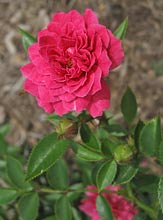 Few of either the Kordes roses or the Earth-Kind varieties are blooming just now. The shrubs may be too young, or maybe I missed the show. Or it could be that the roses need more pampering than they’re getting here to thrive. Among the Kordes roses the cultivar making the best show is one named ‘Roxy.’ It’s a miniature rose with rich red-violet color and petals that shingle like camellias. Few of either the Kordes roses or the Earth-Kind varieties are blooming just now. The shrubs may be too young, or maybe I missed the show. Or it could be that the roses need more pampering than they’re getting here to thrive. Among the Kordes roses the cultivar making the best show is one named ‘Roxy.’ It’s a miniature rose with rich red-violet color and petals that shingle like camellias.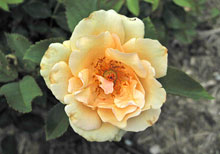 All of the Earth-Kind roses planted here are shrub roses. A variety named ‘Winter Sunset’ has lots of these pale yellow flowers. All of the Earth-Kind roses planted here are shrub roses. A variety named ‘Winter Sunset’ has lots of these pale yellow flowers.From what I see today, I’m not sure either the Earth-Kind or the Kordes roses are the kinds of roses visitors would come to a botanical garden to see. Until the hands-off treatment these roses are getting produces plants with big flowers that never stop blooming atop tall canes with an old-fashioned rose scent and vibrant colors against deep green foliage, they will likely remain just curiosities. 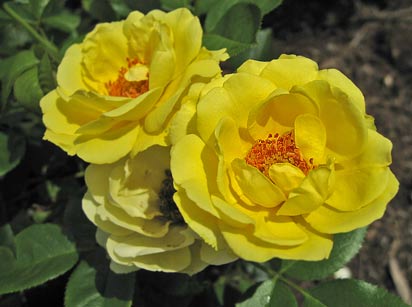 Back to the mainstream roses: The All-America Rose Selections (AARS) program has just announced its winners for 2011: a grandiflora called ‘Dick Clark’ and a floribunda named ‘Walking on Sunshine.’ ‘Walking on Sunshine’ – already has a bed of its own here. The PR description gushes, "This rose is sure to make you happy, even when skies are gray! Round and full like the sun on a hot summer day, this plant's super glossy, disease-resistant foliage contrasts beautifully with the cheery, eye-catching flowers.” After seeing the roses though, I think the over-the-top words may just fit. Today’s morning sunlight on yellow petals that frame but don’t hide the rose’s grainy centers shows why ‘Walking on Sunshine’ is a winner. In a bow to environmentalism and easy care, the AARS now requires that none of the roses contending for top honors be sprayed with fungicides. 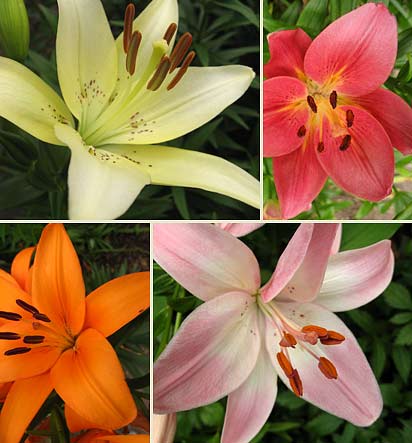 Lilies have replaced the spring bulbs in the bulbs beds. So many shapes, and sizes, and colors. Some have stocks so tall that I’d need a better camera to shoot them. Others, growing on stocks too weak to support their flower clusters, are touching the ground. They all have signs that introduce them, but with lilies I’d rather not know what they are. I just look, smell, and admire. I grew up around cherry trees. There were three huge sour cherry trees in our yard at home. As kids they were our favorite trees to climb because they had branches that laddered up to the top. We also liked to pry off the honey-colored sap that congealed on their trunks and use it as chewing gum. Our cherry trees unfailingly produced cherries – lots and lots of them. As kids it was our job to pick them. As much as we liked climbing the trees for fun, climbing the trees to pick the cherries was work. We complained even though we knew that picking the cherries meant cherry pies now and with the jars that my mom canned, deep into winter too. So we picked. At first we ate almost none of what we picked. Too sour. Then my older cousin discovered that if he put some sugar in his jeans, he could squeeze out the cherry pit, dip the oozing cherry into his pocket, and then eat it. From then on, we all made sure we had sugar in our pockets before we strapped the berry pails to our belts. Since then, no one I have ever known has had a cherry tree, although they will grow just fine here in Zone 6a. “Too much trouble,” the host of a radio call-in show I heard last week said. Too often cherry trees get tricked into flowering before the last frost hits. Then even if they make it through early spring, there are still the aphids, the maggots, the brown rot, and leaf spot all of which need to be kept in check with regular chemical baths. And finally, the birds. They begin stripping the trees even before the fruit reddens. 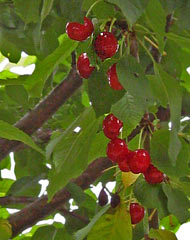 Today though I saw a cherry tree -- one that was loaded with cherries ready for picking. This one, about eight feet tall, is growing in this botanical garden’s Ottoman Garden. It’s identifying marker says it’s a Bird Cherry ‘Lapins’ (Prunus avium). I resisted picking any, but did learn from the web that bird cherries are sweet – though reportedly of “poorer quality” than the familiar “Bing,” but sweet nonetheless.
Today though I saw a cherry tree -- one that was loaded with cherries ready for picking. This one, about eight feet tall, is growing in this botanical garden’s Ottoman Garden. It’s identifying marker says it’s a Bird Cherry ‘Lapins’ (Prunus avium). I resisted picking any, but did learn from the web that bird cherries are sweet – though reportedly of “poorer quality” than the familiar “Bing,” but sweet nonetheless.I did wonder why a cherry tree would be have been planted in an Ottoman Garden though. Turns out it’s right where it should be. The Ottoman Empire was the Prunus avium’s historical home. Cherries originated in the area between the Black and Caspian seas in Asian Minor. From there the spread to Greece and then to Rome where they were scattered all over Europe by Roman soldiers. 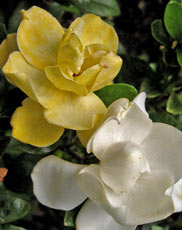 Here’s something that is definitely out of place though -- gardenias planted in the English Woodland Garden. Scattered here and there along the pathways I saw several wonderfully fragrant gardenia shrubs planted in the ground. Each shrub had white and yellow flowers blooming side by side. Nearby signs identified the shrubs as Gardenia jasminiodes ‘Leeone’ Jubilation. Here’s something that is definitely out of place though -- gardenias planted in the English Woodland Garden. Scattered here and there along the pathways I saw several wonderfully fragrant gardenia shrubs planted in the ground. Each shrub had white and yellow flowers blooming side by side. Nearby signs identified the shrubs as Gardenia jasminiodes ‘Leeone’ Jubilation.
When I saw them I thought this gardenia might be some cold-resistant variety much like the hardy camellias that continue to be planted here. Turns out no. ‘Leeone,’ while a new and improved variety of Southern gardenia, is still a gardenia. That makes it marginally hardy up to Zone 7 with winters that touch zero. This botanical garden is in Zone 6 with temperatures that dip well below zero. Makes me wonder whether this tender shrub is just a summer-time delight or whether the botanical garden is experimenting growing out-of-zone plants. |
||||||||||||||||||||||||||||||||||||||||||
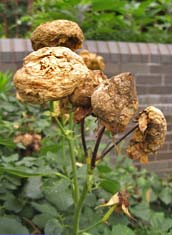 What could have happened to this rose? We saw it in the fragrance garden this morning. It looks as though it had been allowed to bloom and then it was flash frozen. Only the flowers were desiccated though. The leaves were green and healthy.
What could have happened to this rose? We saw it in the fragrance garden this morning. It looks as though it had been allowed to bloom and then it was flash frozen. Only the flowers were desiccated though. The leaves were green and healthy.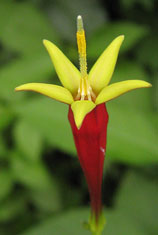 Indian Pink (Spigelia marilandica) is in full bloom this morning in the native plants area of the botanical garden. The sign nearby identifies the plant as a Missouri wildflower, but it doesn’t show up in the
Indian Pink (Spigelia marilandica) is in full bloom this morning in the native plants area of the botanical garden. The sign nearby identifies the plant as a Missouri wildflower, but it doesn’t show up in the 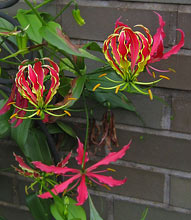 What is it that makes bright red against a lively yellow so striking? Odd that I would have seen this Gloriosa superba just after I’d seen the Indian Pink. This Glory Lily was working its way up a brick wall in full sun outside the Kemper Center. The Glory Lily is a full-on tropical flower native to South Asia and Africa and unlike the Indian Pink it’s here strictly for the summer. Gloriosa is exotic and it looks it.
What is it that makes bright red against a lively yellow so striking? Odd that I would have seen this Gloriosa superba just after I’d seen the Indian Pink. This Glory Lily was working its way up a brick wall in full sun outside the Kemper Center. The Glory Lily is a full-on tropical flower native to South Asia and Africa and unlike the Indian Pink it’s here strictly for the summer. Gloriosa is exotic and it looks it.